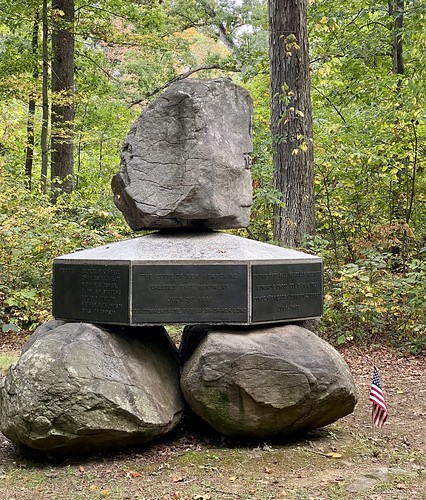Recently, I saw a list of the "best" (not to be missed) monuments at the Gettysburg National Military Park. Most of my favorite monuments didn't make the list. Just because a monument is big doesn't make it best (in my opinion). Here are some of my favorite monuments at Gettysburg.
My favorite is the Maryland monument on Taneytown Road: brother vs. brother. It features two wounded Marylanders, one Union and one Confederate, helping each other on the battlefield. It was dedicated on November 13, 1994. More than 3,000 Marylanders served on both sides of the conflict. It honors them.
Maryland also dedicated the first Confederate monument (in 1884) at Gettysburg. The monument to the 2nd infantry (1st Maryland battalion) is located near Culp's Hill/Spangler's Spring. It was met with some protests from former Union soldiers who saw it as a symbol of everything they fought against. It took years for the next Confederate monuments to find their way to the battlefield.
Another favorite of mine is the 13-foot-high monument of the 11th Pennsylvania at Oak Ridge. The monument consists of a soldier standing atop a granite base. At the base of the monument is a small dog. An American Staffordshire "Pit Bull" Terrier, Sallie Ann Jarrett was the mascot of the 11th Pennsylvania. Sallie was given to the regiment as a puppy. She accompanied her regiment into every one of their battles and was killed in battle only weeks before the war ended. Twice she marched with the regiment in review before President Lincoln.
 |
|
One of the more storied monuments at Gettysburg is the one honoring Confederate General James Longstreet. It is "hidden" in the woods on West Confederate Avenue. The bronze statue was dedicated in 1998, much later than other monuments, even Southern ones. Mom and I met the sculptor Gary Casteel and have visited his shop on several occasions. We like him. He told us about his involvement in creating a National Civil War Memorial and the difficulty in finding a place to locate it.
Unlike other monuments honoring generals, the Longstreet monument does not set on a pedestal. It is at ground level. Some critics think the horse is too small. One of the reasons it took so long for this monument to be erected was because the South did not like Longstreet. They scapegoated him for Gettysburg. Longstreet was critical of Lee and changed political parties after the war. He was a supporter of reconstruction and black suffrage. Needless to say, history views Longstreet more favorably than his Southern detractors.

The other monument that includes a dog is that of the Irish Brigade, one of the most legendary units of the Civil War. The Irish Brigade was formed almost entirely from Irish-Americans from five units: the 63rd, 69th, and 88th New York and eventually the 116th Pennsylvania and 28th Massachusetts. The monument features a Celtic Cross. At the foot of the cross lies a life size Irish Wolfhound. The dog is symbolic of honor and fidelity. The statue was sculpted by a former Confederate soldier who fought at Gettysburg.
The monument to the 5th New Hampshire is one of the most unique monuments at Gettysburg. It has boulders taken from the battlefield joined together by a horizontal, 8-sided stone of New Hampshire granite. The 5th New Hampshire has the unfortunate distinction of being the regiment with the most battle deaths of any Union regimen in the Civil War.
I like the front of the Virginia Monument on West Confederate Avenue. While the monument features a very large Robert E. Lee atop his horse Traveler, I prefer the soldiers at the base of the monument. The seven soldiers are meant to represent individuals who left various occupations to join the war effort, including a farmer and youth. They are facing the Field of Picket's charge and are considered to have defensive postures rather than offensive. The Virginia monument was one of the first Confederate monuments at Gettysburg and has had its share of controversy.
There are approximately 1,328 monuments, markers and memorials at Gettysburg National Military Park. There are monuments to states, units, and individuals. According to Casteel, no additional monuments are allowed. The National Park Service also has no intention of removing any monuments, despite efforts to remove Confederate monuments from public places. They are part of history.






No comments:
Post a Comment